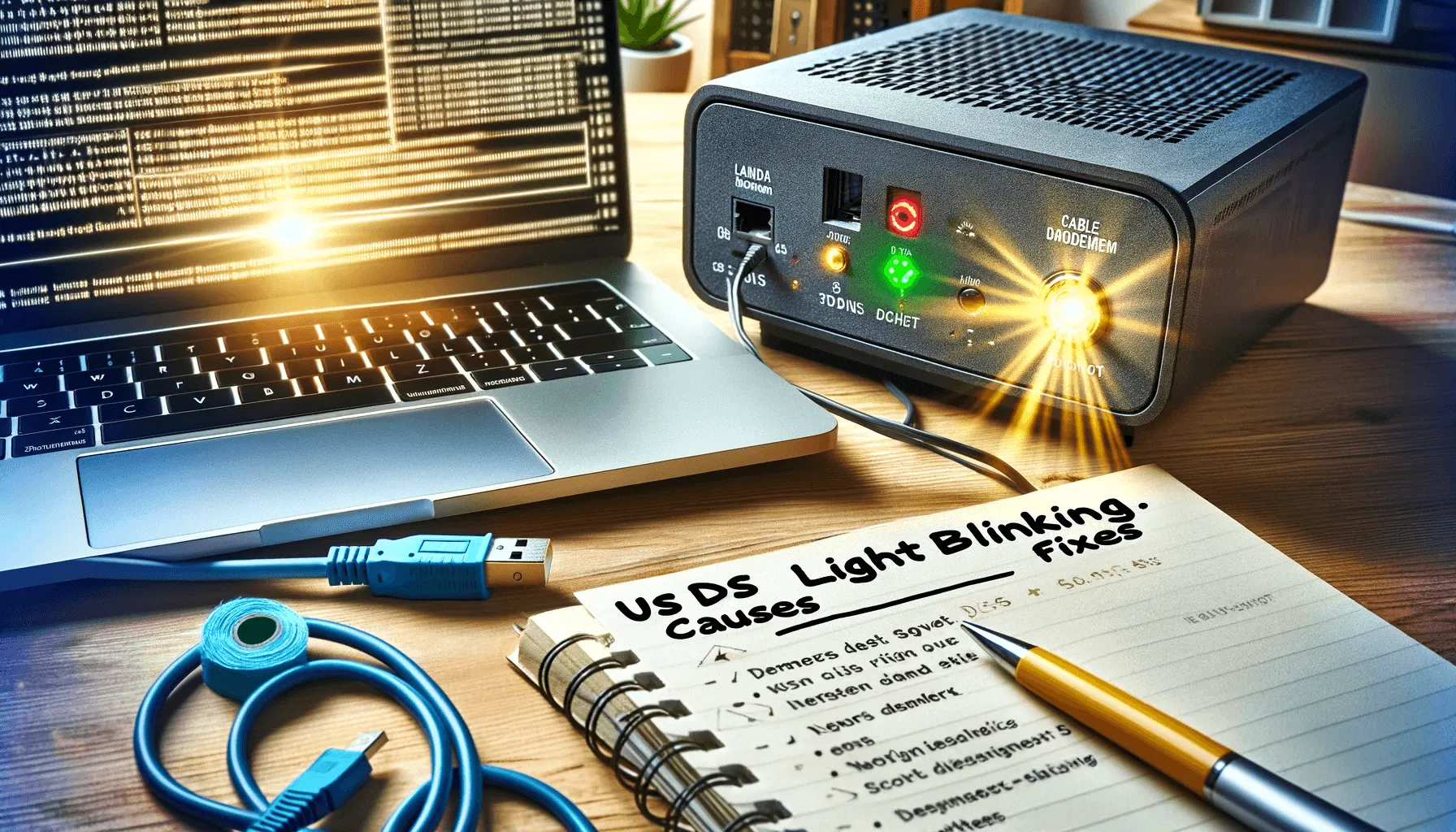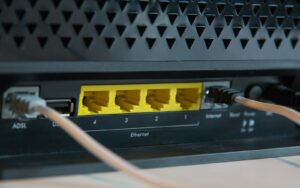A blinking US/DS light typically means your device is having trouble communicating with your Internet Service Provider’s (ISP’s) network. It’s trying hard to connect for data transmission and reception but can’t establish a solid link.
While some US/DS blinking during start-up or firmware updates is normal, if it persists for long periods, you likely have a connectivity problem that requires fixing.
Not to worry, though – in most cases, you can easily restore your internet by following some basic troubleshooting steps. We’ll outline everything you need to know about resolving US/DS blinking issues on your own without waiting for a service technician.
Quick Fix for US/DS light blinking– Reboot your Internet modem/router by unplugging the wire from the electric socket for at least one minute and plug it in again.
Key Takeaways – US/DS Blinking Light
- 💡 Blinking US/DS light often signifies connectivity issues between your modem and ISP.
- 🔌 Common causes include loose or faulty cables, hardware failures, and ISP network outages.
- 🔄 Try rebooting modems, checking cables, switching outlets, and replacing any visibly damaged coaxial cables, splitters, and modems.
- 🌐 Check for ISP outages online or with neighbors to confirm wider service issues.
- 🚦 Different light states (blinking, solid, no light) indicate various connection statuses.
- ⚡ Power disruptions and surges can also cause blinking US/DS lights; consider a UPS for stability.
- 💳 Unpaid internet bills might lead to intentional service interruptions by ISPs.
- 📶 Congested bandwidth from multiple devices can overload connections, leading to blinking lights.
- 🔄 Factory resetting the modem and updating firmware are advanced steps for troubleshooting.
- 📞 If problems persist, contacting your ISP for technical support or equipment replacement is advised.
- 📡 Proactive measures like regular firmware updates and gentle handling of equipment can prevent issues.
What Does a Blinking US/DS Light Mean?
A blinking US/DS light typically means your device is struggling to communicate with your ISP’s network, indicating connectivity issues that need troubleshooting. It signifies problems syncing with your ISP, while a solid light indicates a strong connection, and no light means no connection at all.
US/DS stands for “upstream” and “downstream” – these refer to the two directions of your internet connection. The upstream is the connection sending data from your devices to the internet, while downstream brings data to you.
To better understand these indicators, consider the following scenarios:
| State of US/DS Light | Meaning |
| Flashing Slowly | The US/DS will blink temporarily when first powering on your device as it searches for and connects to your ISP’s network. This is normal. |
| Blinking fast with shorter intervals | It indicates your home router/modem is having issues syncing with your ISP. |
| Solid Light | A solid US/DS light means your modem/router has established a strong signal and active internet connection with your ISP. Data is flowing as expected. |
| No Light | Having no US/DS light means the connection with your ISP is completely inactive or unavailable. |
So, in summary, a solid light = a good connection, blinking = connecting/intermittent connection issues, and no light = no connection.
If you notice long periods of blinking or no US/DS lights, your internet connectivity is impaired. Let’s look at why this happens and how to restore it.
Why Does My US/DS Light Keep Blinking? Common Causes
There are a handful of common culprits for US/DS blinking connectivity problems:
- Internet or ISP network outages
- Loose modem/router cables
- Faulty coaxial cables, connectors or splitters
- Congested bandwidth or connection overload
- Firmware updates
- Power failures or surges
- Paying overdue internet bills
- Hardware failure
Let’s break these down in more detail:
1. Internet and Network Outages
Service interruptions are probably the most frequent triggers for US/DS blinking. ISPs occasionally go down for large regions due to:
- Mass network equipment failures
- Infrastructure damage from natural disasters
- Planned maintenance windows
When this happens, even if your modem and in-home connections are fine, the break in your ISP link causes the US/DS blinking while it searches for a connection.
You’ll typically see service updates for widespread regional outages on your ISP’s website, app notifications or social media pages.
For smaller neighborhoods, reach out to neighbors to see if they have connectivity before assuming an isolated equipment issue. Outages don’t require any action beyond waiting patiently for restoration.
Here are the outage maps for some popular internet service providers located across the United States:
Alternatively, you can search for ISP outages at https://downdetector.com/
2. Loose Cables
Like any electronic or electric device, modems and routers rely on secure physical connections to function.
If power cords or data cables like coaxial or Ethernet become slightly loose from vibrations or accidental bumps, it can create enough instability for US/DS lights to blink. This is easily remedied by firmly reseating all connectors.
3. Faulty Cables and Hardware
On the flip side, cables and ancillary hardware like splitters that have aged and degraded transmission integrity can also impair connectivity.
Examine any coaxial runs, connectors, and splitters for:
- Visible cracks, tears or holes
- Corrosion or rust
- Crimped or severely bent segments
Any defects indicate it’s time to swap in new replacement hardware.
4. Congested Bandwidth and Overloads
Like a crowded highway with too many vehicles, your home’s internet bandwidth can also become congested.
If you routinely power multiple high-bandwidth applications like gaming, video streaming or file downloads simultaneously, it may exceed your connection’s capacity. This forces your ISP link to buffer and blink.
Try spacing out bandwidth-intensive tasks or upgrading your internet plan’s speed if this fits the bill.
5. Firmware Updates
As modems and routers evolve, manufacturers periodically release revised firmware – basically software that runs on the device.
Installation causes US/DS blinking in short bursts as the update patches your hardware’s code. It’s completely harmless for functionality, so never disrupt the process. Just let changes finalize over 15-20 minutes until lights solidify.
6. Power Disruptions
Given their always-on nature, modems and routers hate power inconsistencies. Surges, spikes and outages from electrical storms or blackouts can overload protective circuits.
Afterward, US/DS connectivity may blink while systems reboot and recalibrate. Consider getting an uninterrupted power supply (UPS) backup battery if electrical stability is an issue in your area.
7. Unpaid Internet Bills
While it seems harsh, some ISPs will intentionally disable service by blocking modem communication when customers fall delinquent on monthly payments. This also triggers nonstop US/DS blinking.
Check account balances if blinks coincide with billing cycles as a quick fix.
8. Faulty Hardware
Lastly, if you’ve eliminated all other potential factors, basic component degradation may be preventing your modem or router hardware from syncing properly. At that point replacement is your best recourse.
Step-By-Step Guide to Fixing Blinking US/DS Lights
Before calling your ISP or replacing equipment, there are basic troubleshooting steps you can take to try and resolve a blinking US/DS light yourself:
- Step 1: Check for Outages
- Step 2: Power Cycle the Modem and Router
- Step 3: Check for Outstanding Internet Bills
- Step 4: Replace Faulty Hardware
- Step 5: Factory Reset Your Modem
- Step 6: Reduce Bandwidth Congestion
- Step 7: Update Modem/Router Firmware
- Step 8: Contact Your ISP
Step 1: Check for Outages
Your ISP likely has an outage map or status page on their website or mobile app. Look up your area to see if there are any reported issues. Many times, simply waiting out an outage will restore your connection without other action needed.
Here are the outage maps for some popular internet service providers located across the United States:
You can search for ISP outages at https://downdetector.com/
Alternatively,
- Check social media for customer complaints
- Contact neighbors to confirm an isolated issue
- If there is a major outage, just patiently wait for restoration (it may take hours)
Step 2: Power Cycle the Modem and Router
Rebooting your equipment essentially gives it a fresh start, clearing any software hiccups. Here are the steps:
- Unplug the power cable from your modem and router.
- Wait at least one full minute before plugging them back in.
- Make sure your modem boots up fully (about 2-3 extra minutes) before reconnecting your router.
This power cycle flushes out any glitches and reestablishes the hardware connections.
Check the US DS light status. Remember solid light = a good connection, blinking = connecting/intermittent connection issues, and no light = no connection. Stop here if you see solid light , then check Internet connectivity on all your devices. If the US/DS light is still blinking move on to the next step.
Ensure Coaxial Cables are Tight
Loose cabling is a prevalent issue. Verify all coaxial cable connections at both ends are screwed in completely finger-tight. Check the connections to your modem, router, and any wall outlets or splitters.
- Firmly push all connectors into their ports
- Electrical
- Coaxial
- Ethernet
Try Different Coaxial Outlets
Not all outlets in your home necessarily work, even if they are coaxial outlets. Plug your modem’s coaxial cable into a different jack to see if that resolves the blinking light.
Test internet once US/DS lights solidify.
Step 3: Check for Outstanding Internet Bills
Sometimes, a blinking US/DS light means your ISP has temporarily interrupted service due to late payments. Log into your account and make any overdue payments to restore connectivity.
Step 4: Replace Faulty Hardware
If you’ve tried the above steps with no success, the issue may lie with your cables or modem itself. Here’s how to pinpoint and replace defective hardware:
Swap Out Damaged Coaxial Cables
Inspect all coaxial cables for any kinks, cracks, corrosion, or other damage. If found, replace the faulty cables with brand-new ones. This includes cables inside your home as well as the one coming from the telephone pole outside.
Replace a Malfunctioning Coaxial Splitter
If you use your coaxial connection for both internet and TV, check that the splitter connecting them is not defective. Switch it out with a known working splitter to restore full signal strength.
Purchase a New Modem
If your modem is older or malfunctioning, no amount of resets and reboots will solve the problem permanently. Contact your ISP about replacing your leased modem or purchase your own compatible model.
Step 5: Factory Reset Your Modem
If you’d prefer not to replace your modem just yet, resetting it can frequently resolve a blinking US/DS light. Resetting flushes out bad software and resets all connections.
Perform a Factory Reset
Consult your modem manual for the proper reset procedure. In most cases, it involves pressing and holding the reset button on the back until lights flash. This returns settings to factory default.
Instructions for Popular Providers
For Arris modems, hold the reset button for over 8 seconds.
You can reset the Spectrum modem by holding the button for at least 15 seconds.
You can reset the Xfinity modem by holding the button for at least 15-20 seconds.
You can reset the AT&T router by holding the button for at least 15-20 seconds.
Power Cycle Before and After
Be sure to power cycle your modem before and after a factory reset to clear out residual connection issues. Allow several minutes for the reset process to fully complete.
Step 6: Reduce Bandwidth Congestion
If Steps 1-3 fail to establish solid connectivity, try easing bandwidth loads.
- Pause/disconnect any non-critical network devices
- Temporarily disable WiFi devices able to connect via cellular data instead
- Stop extended high-bandwidth tasks like large uploads/downloads
- Stagger times for data-heavy gaming, video or VPN sessions
This determines if oversubscription plays a role. We can optimize better if it does.
Step 7: Update Modem/Router Firmware
Firmware revisions patch stability issues and keep connectivity current.
You’ll need a PC/laptop connection via Ethernet cable to access your modem interface and router admin panel. From there:
- Identify current firmware versions
- Check manufacturer sites for available updates
- Download and initiate automated flash installation
- Let changes apply without interrupting
- Modems take ~15-20 minutes, routers vary
Set a routine calendar reminder to recheck every 2-3 months.
Step 8: Contact Your ISP
If you still see a blinking US/DS light after trying all troubleshooting steps yourself, it’s time to bring in reinforcements. Contact your ISP’s tech support for assistance fixing the issue.
Request Technical Support
Your ISP can run remote diagnostics, provision your equipment, and detect any problems on their network causing your connectivity problems. They have the best tools to fix issues with your service.
Ask for a Technician Visit
For cabling problems or defective leased equipment, your ISP can send a technician to inspect everything on-site and make needed repairs. Make sure to request a technical visit if needed.
Inquire About Modem Replacement
If your modem is provided by your ISP and is confirmed to be faulty, ask about getting it replaced. Leased modems with issues can often be swapped out at no cost.
Preventing Future Blinking US/DS Lights
While any modem can incur glitches causing a blinking US/DS light, you can take proactive measures to avoid connectivity headaches:
- Avoid overloads: Audit network device volume and stagger bandwidth usage times
- Update firmware routinely: Check manufacturer sites quarterly
- Use UPS battery backup: Protect against power surges/blips
- Keep hardware current: Modems/routers degrade so replace older units
- Isolate supply lines: Connect equipment to outlets independent of major appliances
- Maintain connections: Periodically reseat connectors that may vibrate loose
- Consider mesh systems: Alternative to stabilizing modem/router combos
- Handle modems and cables gently to prevent physical damage.
- Keep your modem firmware updated by checking the manufacturer’s website.
- Pay internet bills on time to avoid service suspensions.
- Consider purchasing your own compatible modem for greater control.
Investing a little time up front significantly reduces headaches down the road!
Conclusion
Hopefully this guide has equipped you to better handle that pesky blinking US/DS light situation. Just know the solution is usually within your grasp with some systematic problem-solving. Patience and constantly checking connections goes a long way. But for any persistent problems, never hesitate to tap into your ISP’s technical expertise.
Frequently Asked Questions (FAQs)
How long should US/DS lights blink on new modem connection?
When first installing modems, it’s normal for US/DS blinking to persist 5-10 minutes during detection and synchronization to ISP networks. Anything longer typically indicates an issue.
Does US/DS blinking mean no internet connection?
Not necessarily. Blinking means the modem is struggling to establish and hold a steady ISP link. Brief drops may let partial data packets through. But sustained blinking degrades connectivity. Think of it as a spectrum from 1-10:
- 1-2 blinks = high-speed connection
- 3-4 blinks = slower speeds with some buffering
- 5+ blinks = extremely slow to no connection
If you’re noticing usage lagging but data does go through, it’s best to proactively fix lighting sooner than later.
Why does my US/DS light stay orange?
Solid orange US/DS lighting can mean two things:
- The modem synchronized successfully but data transfer speed is constrained for some reason. Continued traffic is passing through but intermittently buffering, resulting in slower effective bandwidth.
- Most ISPs actually assign a US or DS channel an orange identifier at setup. If solid, that specific upstream or downstream node has linked but the other side may still have issues.
You need both US and DS solid (usually green) for peak performance. Check your router interface details – identifying unique colors is tricky.
What causes the modem router combo US/DS light to turn red?
A solid red US/DS light usually indicates a total connectivity failure – essentially the worst-case scenario.
Your modem cannot initialize channels to begin negotiating links with your ISP. This points to either internal hardware problems or no carrier detection from the wall jack (no dial tone for legacy phone services).
Unless you have absolutely verified ISP or wiring issues first, a red light means your modem requires replacement right away.





